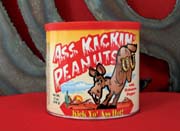

But if you think a bite of the world's hottest habanero pepper is the only thing that can bring a tear to your eye, think again. Bringing the line in-house brought its own challenges. "The biggest roadblock we faced in bringing the peanut line in-house was nitrogen flushing," says Jeff Jacobs, president of Southwest Specialty Food. "Historically, this operation involved a huge nitrogen gas tunnel." The company needed to find a nitrogen flushing system that occupied a smaller footprint and reduced the oxygen headspace of the package, which would help maintain product freshness and extend shelf life. Southwest Specialty chose VBS Industries and its LCI-300 Auto Fill, a small automated liquid nitrogen (LN2) injection system.
Following the filler, the VBS system meters a small dose of liquid nitrogen into each container. As the nitrogen warms from -320